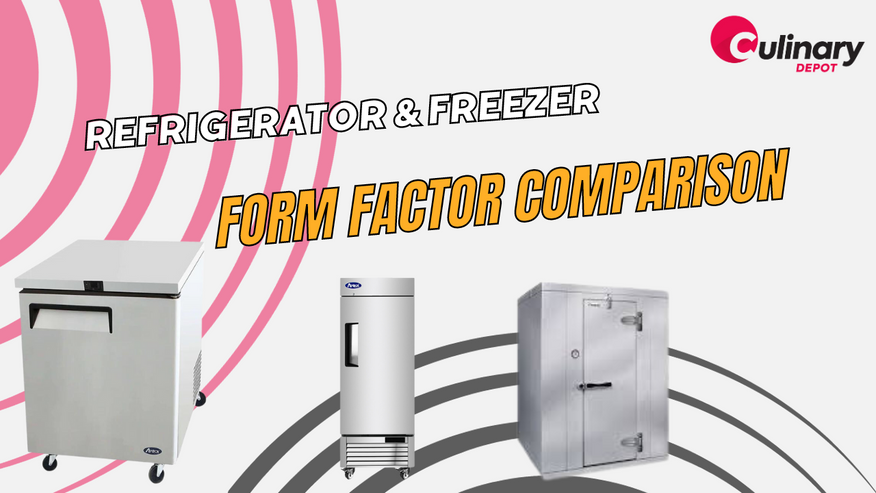Sep 26th 2023 - Team Member
Refrigerator & Freezer Form Factor Comparison
When it comes to equipping your commercial kitchen with refrigeration and freezer solutions, choosing the right form factor is crucial. The form factor refers to the physical design and layout of the refrigerator or freezer. It's not just about aesthetics; it directly impacts the efficiency of your kitchen, storage capacity, and workflow. In this comprehensive guide, we will compare different refrigerator and freezer form factors to help you make an informed decision that suits your commercial kitchen's needs.
Understanding Refrigerator and Freezer Form Factors
Reach-In Refrigerators and Freezers
Overview

- Design: These units typically feature upright, single, or double doors that open outward.
- Usage: Ideal for high-traffic kitchens requiring frequent access to ingredients.
- Storage: Shelves or racks provide organized storage for food items.
Pros
- Easy access to contents without excessive bending or reaching.
- Allows segregation of different food items on separate shelves.
- Suitable for quick and busy kitchen environments.
Cons
- Takes up more floor space compared to other form factors.
- May not offer as much storage capacity as walk-in units.
Walk-In Refrigerators and Freezers
Overview

- Design: These are room-sized refrigeration units with a door or set of doors for entry.
- Usage: Perfect for large kitchens with extensive storage needs.
- Storage: Provides ample space for bulk storage on racks or shelving.
Kolpak KF7-0608-FR
Pros
- Offers the highest storage capacity among all form factors.
- Ideal for storing large quantities of perishable items.
- Provides space for organized inventory management.
Cons
- Requires a significant amount of floor space.
- Installation can be costly and time-consuming.
Undercounter Refrigerators and Freezers
Overview

- Design: Compact units designed to fit beneath countertops.
- Usage: Suited for kitchens with limited space or for storing frequently used items.
- Storage: Typically have shelves and drawers for organized storage.
Pros
- Space-efficient and doesn't take up valuable floor space.
- Convenient for quick access to ingredients near food preparation areas.
- Ideal for small kitchens or where space is at a premium.
Cons
- Limited storage capacity compared to reach-in or walk-in units.
- May not be suitable for bulk storage needs.
Choosing the Right Form Factor
Factors to Consider
When deciding on the ideal refrigerator and freezer form factor for your commercial kitchen, consider these key factors:
Space Availability
- Assess the available space in your kitchen. Walk-in units require ample floor space, while under-counter units are space-efficient.
Storage Needs
- Determine your storage needs based on the volume of perishable items you handle daily.
Workflow Efficiency
- Consider how the form factor affects your kitchen's workflow. Reach-in units are convenient for quick access, while walk-ins are designed for bulk storage.
Budget
- Factor in your budget constraints. Walk-in units may be costlier to install and operate.
Conclusion
Selecting the right refrigerator and freezer form factor is a critical decision for any commercial kitchen. It impacts the efficiency of your operations, the organization of your ingredients, and even the layout of your kitchen space.
By understanding the advantages and disadvantages of reach-in, walk-in, and under-counter units, you can make an informed choice that aligns with your kitchen's unique needs and helps you maintain the freshness and quality of your food items while optimizing your kitchen's workflow.
Remember to consider your kitchen's available space, storage requirements, workflow, and budget before making a final decision. The right form factor can enhance your kitchen's functionality and ultimately contribute to the success of your culinary endeavors.

